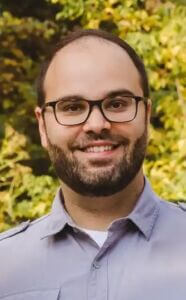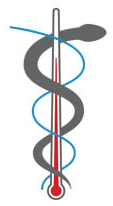2026 Webinar Series
Join The Society for Thermal Medicine’s Webinar Series, where innovation meets impact. Experience thought-provoking discussions led by leading experts as we explore cutting-edge topics that are shaping the future of thermal therapy and beyond!
Registration Fees
- STM Members: Free Access
- Non-Members: $25/webinar
Sessions Include
- Distinguished speakers
- High-Value content
- Global Relevance
Sponsorship by industry leaders in thermal technology
2026 Webinars
Webinar Archive
 Dr. Robert J Griffin, PhD Professor, University of Arkansas for Medical Sciences / Department of Radiation Oncology / Radiation Biology section
Dr. Robert J Griffin, PhD Professor, University of Arkansas for Medical Sciences / Department of Radiation Oncology / Radiation Biology section
"Hyperthermia enhances spatially-fractionated radiation and immunotherapy in pre-clinical tumor models"
November Webinar Synopsis
The webinar presentation will cover our work to understand the effects of mild and moderate local hyperthermia on the solid tumor microenvironment. Specifically, the data presented will be our recent work to incorporate hyperthermia into an immunotherapy regimen in combination with spatially fractionated radiotherapy (SFRT) in murine cancer models. Spatial fractionation is the delivery of highly heterogeneous radiation dose patterns to create high and low dose regions called peaks and valleys. The biological effects of this approach have been observed to be distinctly different than an equal average dose of radiation delivered homogenously across a tumor volume. The theorized mechanisms behind this include altered bystander cell killing between the high and low radiation doses as well as possible remote (abscopal) effects induced by cytokine or other bioactive molecules/chemical species secreted from the high dose areas. Other major areas that have been documented to contribute to SFRT effect are vascular damage/activation and possible induction of anti-tumor immunity.
Considering that all of the processes named above are likely affected by hyperthermic temperatures in vivo, we have studied the effect of 42.5°C local hyperthermia on the same day as SFRT is delivered, followed by our standard regimen of immunotherapy. The results have been dramatic in that nearly all tumors treated with hyperthermia, SFRT and immunotherapy were significantly regressed or delayed in regrowth compared to any of the single treatments, regardless of the sequence of heat and radiotherapy. Re-challenge experiments also demonstrated a durable immune response in a majority of the heat-treated tumors. In addition to our study data, broader concepts of using thermal dose/history to boost the ability of the host to activate immunity during cancer therapy in general will be discussed.
Robert J. Griffin, PhD is a professor of Radiation Biology in the Department of Radiation Oncology at the University of Arkansas for Medical Sciences (UAMS). A large part of his research has involved characterizing the effects of thermal therapy at mild or ablative levels on the solid tumor microenvironment and how to exploit these effects to improve tumor control with various therapeutic modalities. He worked and completed a PhD in Biophysical Sciences with Dr. Chang W. Song in 1998 at the University of Minnesota and was subsequently an assistant professor in Therapeutic Radiology there. He moved to UAMS in 2006 as associate professor in the radiobiology division of the department of Radiation Oncology. He has been a member of the Society for Thermal Medicine since ~1995 and has published over 175 peer reviewed papers. Most recently, he has been working part time as vice president for small business development and faculty affairs in the technology transfer office at UAMS (BioVentures) and is helping lead a newly funded NIH/NCI R25 on Cancer technology commercialization training.
Investigations using nanomaterials (e.g., nanoliposomes and various nanomedicines) for targeted delivery to the tumor vasculature to improve responses to radiation, thermal treatment, or chemotherapy have been an additional focus in his research group. A related project was as principal investigator for a startup company at UAMS to develop a radiation-triggered liposome for tumor selective drug release with the support of an SBIR contract award from the NCI. The work in his research group has been supported by continuous funding from the NIH or NSF since 2004. In 2023-2024, Dr. Griffin was fortunate to receive a sabbatical fellowship from the Curie Institute and the University of Paris-Saclay to support a research project in Paris on spatially fractionated proton therapy and immunotherapy. He is a past President and program chair for the Society for Thermal Medicine and has served on various committees for STM, the American Society for Radiation Oncology (ASTRO) and the Radiation Research Society. Current editorial posts include Seminars in Radiation Oncology, associate senior editor for radiotherapy for Technology in Cancer Research and Treatment, Radiation Research, and section editor for biology for the International Journal of Hyperthermia.
 Mehdi Vahab, Academic Manager for Mechanical and Aerospace Engineering at MathWorks
Mehdi Vahab, Academic Manager for Mechanical and Aerospace Engineering at MathWorks
Mehdi Vahab is the Academic Manager for Mechanical and Aerospace Engineering at MathWorks. His academic background is in physical modeling, specifically for fluid and thermal systems, and applications of computational modeling in different engineering problems. Before joining MathWorks, he developed numerical methods for the computational modeling of multiphase/multimaterial systems and phase-change dynamics throughout his research career. He applied those methods to study thermofluidics phenomena at different scales and design thermal management systems. At MathWorks, he helps researchers, faculty, and students in Mechanical and Aerospace Engineering with their research and teaching challenges by collaborating and consulting to find better and more accessible solutions.
AI Surrogate Modeling for Thermal Simulation
Recent advances in scientific and physics-informed machine learning have introduced a range of neural network architectures capable of approximating solutions to partial differential equations (PDEs), offering new opportunities for accelerating thermal simulations in medicine and engineering. This talk explores several AI-based surrogate modeling techniques, including Physics-Informed Neural Networks (PINNs), Fourier Neural Operators (FNOs), Graph Neural Networks (GNNs), and transformer-based approaches, for solving heat transfer problems governed by the heat equation. Using MATLAB, we demonstrate how these methods can be applied to simulate temperature distributions in 2D and 3D. We will show how to build and train these models in MATLAB, using training data generated from high-fidelity finite element simulations via Partial Differential Equation Toolbox.
- PINNs incorporate the governing PDE directly into the loss function, enabling mesh-free learning from sparse data. In addition to forward modeling, we show how PINNs can be used for inverse problems, such as estimating thermal conductivity from limited temperature measurements, which is necessary when direct measurement is impractical.
- FNOs learn maps between function spaces, offering fast inference on unseen conditions.
- GNNs operate on graph-structured data, making them well-suited for predicting temperature on complex geometries.
 Speaker: Dr. Dario Rodrigues, PhD, Department of Radiation Oncology, University of Maryland School of Medicine, Baltimore MD
Speaker: Dr. Dario Rodrigues, PhD, Department of Radiation Oncology, University of Maryland School of Medicine, Baltimore MD
Webinar Summary*: Hyperthermia therapy (HT) enhances the efficacy of radiation and chemotherapy by raising tumor temperatures to 40–44 °C for approximately one hour. Clinical devices based on microwave (MW) and radiofrequency (RF) energy offer versatile heating methods capable of treating a wide range of tumor sites, regardless of size or depth. This webinar will provide an overview of the physics underpinning MW/RF hyperthermia, the current generation of systems used for both local and regional heating, methods for temperature monitoring, and recent advances in treatment planning and real-time, MRI-guided noninvasive therapy.
Clinical hyperthermia can be delivered invasively or noninvasively through externally applied energy. MW-based systems (434 or 915 MHz) are primarily used for localized treatment of superficial and deep tumors, via external, intraluminal, or interstitial methods. In contrast, RF-based systems (70–120 MHz) are used for regional hyperthermia, particularly for pelvic and abdominal tumors, using phased-array applicators. Regardless of modality, temperature monitoring is essential for safe and effective treatment and relies on RF/MW-insensitive probes such as fiber-optic sensors or custom thermistors.
Hyperthermia is typically administered 1–3 times per week. As tissues heat, dynamic physiological responses such as increased blood flow alter energy absorption, requiring careful power adjustment and control. Continuous temperature monitoring, surface cooling, and patient feedback are critical for maintaining safety and avoiding complications such as pain or thermal injury from overheating.
Several technical challenges continue to limit optimal hyperthermia delivery, including bulky applicators, inadequate temperature monitoring capabilities, and rudimentary treatment planning software. Despite these challenges, dozens of clinical trials strongly support the use of adjuvant HT since it significantly improves curative and palliative clinical outcomes. Recent technological advances will further improve treatment delivery and reduce its complexity, which are pivotal components for expanding the use of HT at medical and radiation oncology centers.
*A recording of this webinar may be viewed in the “Resources” area of the STM Member’s Only Info Hub, gratis for all active and paid members.
Not an STM member? Become one today!
 Speakers: Dr. Chris Osswald, PhD, Director and Global Segment Leader for Laser Therapy at ClearPoint Neuro (CLPT) and Verena Knappe, Chief Product Officer at Clinical Laserthermia Systems (CLS)
Speakers: Dr. Chris Osswald, PhD, Director and Global Segment Leader for Laser Therapy at ClearPoint Neuro (CLPT) and Verena Knappe, Chief Product Officer at Clinical Laserthermia Systems (CLS)
Webinar Summary*: The ClearPoint Prism® Neuro Laser Therapy System evolved from a system originally designed for immune stimulation. It has been optimized for focal ablations within the neurosurgery field and is the only commercially available, non-cooled neuro LITT system. Device background, performance metrics, and clinical utility will be presented.
*A recording of this webinar may be viewed in the “Resources” area of the STM Member’s Only Info Hub, gratis for all active and paid members.
Not an STM member? Become one today!
